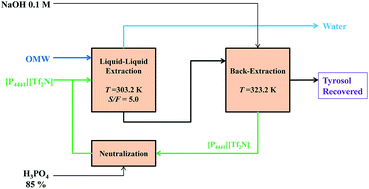Recovery of tyrosol from aqueous streams using hydrophobic ionic liquids: a first step towards developing sustainable processes for olive mill wastewater (OMW) management†
Abstract
Tyrosol is a high-value added polyphenolic compound with inherent antioxidant properties and increasing market demand for pharmaceutical, cosmetic and food industry applications. As a natural occurring antioxidant, the main source of tyrosol is olive mill wastewater (OMW), a by-product of olive oil processing that causes serious environmental issues due to its large volumes with high organic loads. Therefore, the valorization of OMW by recovering valuable antioxidants whilst reducing the overall toxicity of the aqueous stream is an attractive approach to promote sustainable OMW treatment and management. Herein we propose the utilization of hydrophobic ionic liquids (ILs) to replace conventional volatile organic compounds (VOCs) as extraction solvents to recover tyrosol from aqueous solutions. The operating temperature, the solvent to feed ratio, the effect of salt addition, the solvent physical properties and the solvent structure have been studied to optimize the extraction efficiency of tyrosol from water using [P4441][Tf2N], [N4441][Tf2N], and [N8881][Tf2N] ILs. Comprehensive experimental comparisons using ethyl acetate as a benchmark VOC solvent for tyrosol recovery have been performed. Moreover, the regeneration of the ILs and their subsequent recycling into the tyrosol extraction process have been addressed. Results show the capability of the aforementioned ILs to efficiently recover tyrosol under optimum operating conditions. Adding sodium salts, mainly NaCl, was proven to enhance the tyrosol selectivity towards the IL phase. Moreover, the solubility of ILs in the aqueous phase was found negligible, unlike ethyl acetate, and the water solubility in ethyl acetate was notably higher than in the hydrophobic ILs. Furthermore, back-extraction of tyrosol using inexpensive NaOH followed by IL recycling into the extraction process was successfully accomplished. Additional quantum chemical calculations were performed to provide insights into the behaviour of tyrosol–IL systems. Finally, [P4441][Tf2N] was revealed particularly promising for tyrosol recovery, providing similar extraction efficiency as conventional VOC solvents, proven capacity for regeneration and subsequent recycling, and adequate physical properties.



 Please wait while we load your content...
Please wait while we load your content...